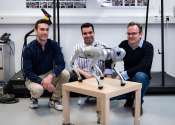Robot mimics vertebrate motion
Based on X-ray videos, EPFL scientists have invented a new robot that mimics the way salamanders walk and swim with unprecedented detail: a tool for understanding the evolution of vertebrate locomotion.
Jun 29, 2016
0
523









